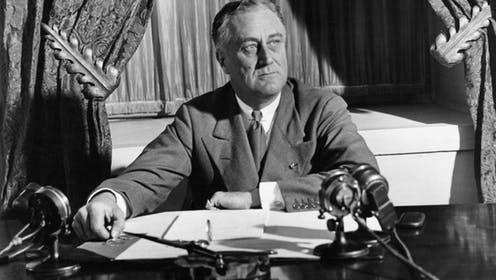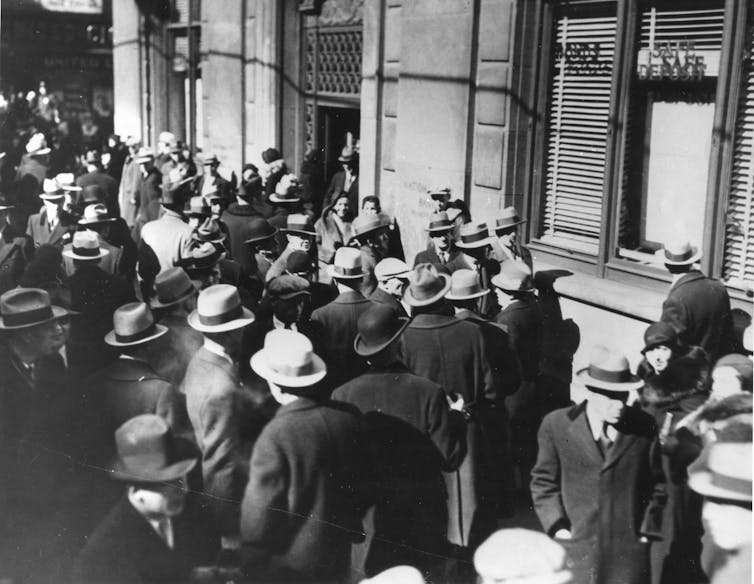President Franklin D. Roosevelt and his advisers knew he had to do something.
The U.S. banking system faced imminent collapse; depositors around the country waited anxiously in line to withdraw their funds. To stop the run, on March 6, 1933, the entire banking system was shuttered. Three days later, Congress passed the Emergency Banking Act.
By March 12, with the banks ready to reopen, nobody knew what was about to happen. The nation required both information and assurance.
So at 10 p.m. Eastern time, Roosevelt began his first “fireside chat,” to explain – in clear and accessible terms – precisely what had just occurred, and what was going to happen beginning the next day.
That live address from the White House to an estimated 60 million listeners across the United States proved broadcasting’s power as nothing before or since. As a scholar of radio history, I’ve analyzed how that first fireside chat inspired both social psychologists and commercial advertisers to investigate the influential power of broadcasting.
Roosevelt’s address 87 years ago provided the model future presidents would use to inform the American citizenry, calm national anxieties and establish the crucial importance of a moment in time.
The live, prime-time address from the Oval Office became a staple of White House communication.
Broadcast’s political potential
The first president to speak through the new medium of radio was Warren G. Harding, who offered a few words in a brief public ceremony on June 14, 1922.
But for Harding, and successors Calvin Coolidge and Herbert Hoover, radio broadcasting – and the national communication it offered – was never considered an essential tool of governance. None of the three Republicans used this new medium of mass communication effectively.
In New York state, however, the Democratic governor – Franklin D. Roosevelt – had begun using the state’s small radio network to promote his agenda directly to citizens.
He delivered a series of radio addresses in 1929 and 1930 to counter the intransigence of the state legislature’s Republican majority. His advisers noted both Roosevelt’s natural talent and radio’s remarkable effectiveness in reaching voters directly. The governor could bypass not only his opposition in the legislature, but also the Republican newspapers editorializing against his policies.
By speaking directly to citizens, Roosevelt measurably influenced public opinion and successfully promoted his policies.
Roosevelt and his advisers brought this awareness to Washington after he won the presidential election.
Calming the panic
Following his March 4, 1933, inauguration during the Great Depression, the Roosevelt administration had to address the cascading series of dire crises facing the nation.
The banking crisis proved most threatening. At first it appeared to be yet another economic panic of the sort that had occasionally bedeviled the U.S. financial system.
Depositors gathered outside of the Guardian Trust Company and National City Bank after the withdrawals were limited to 5% of deposits, Cleveland, Ohio, Feb. 28, 1933. Getty/PhotoQuest
It soon became obvious that the 1932-1933 crisis was potentially more catastrophic than any earlier panic. Aside from legislation, something less formal but perhaps more important was required: reassuring the American people about the safety of their economic system.
Thus, the informal and informative radio address style that Roosevelt pioneered in Albany was rolled out on the national stage.
“I want to talk for a few minutes with the people of the United States about banking,” he began on that Sunday evening.
The address was notable for its stylistic clarity and the way it combined an authoritative discussion of banking with a neighborly, even friendly, tone.
“You people must have faith; you must not be stampeded by rumors or guesses,” he told an estimated 60 million listeners.
“Let us unite in banishing fear. We have provided the machinery to restore our financial system; it is up to you to support and make it work. It is your problem no less than it is mine. Together we cannot fail.”
It worked. It so calmed the nation while slowing (and eventually ending) the bank run that it established the model for all ensuing fireside chats over the next 12 years. Every succeeding president eventually followed the basic Roosevelt model.
‘Important and historic information’
The live, prime-time national address from the White House represents a unique opportunity for a presidency. If mishandled or improperly employed, it can backfire.
Among those that didn’t work out: Lyndon B. Johnson surprised the country and much of his Democratic constituency by announcing his refusal to run for reelection in 1968. President Jimmy Carter addressed what he considered a “crisis of confidence” in the United States in 1979. That speech remains tarnished by a word Carter never actually uttered – it was labeled the “malaise” speech – and it warned future presidents about the format’s rhetorical limits.
Jimmy Carter’s full ‘crisis of confidence’ speech (July 15, 1979).
Yet these bad examples do not overshadow the numerous other historical moments when the nation experienced direct presidential addresses via broadcasting.
From President Harry Truman’s addresses announcing the surrenders of Germany and Japan in 1945 to President Barack Obama declaring the capture and execution of Osama bin Laden in 2011, the American people were given important and historic information direct from the White House through the same basic framework that Roosevelt pioneered 87 years ago.
The coronavirus and an anxious public
Several goals characterize the prime-time, scripted, live Oval Office address.
The first is to designate the subject under discussion as historically significant and worthy of the format. The second is to inform the citizenry in order to persuade people to believe or act in specific ways. The third is to reassure the nation.
Underlying those objectives: To establish confidence in presidential authority, which, by itself, should reassure.
In the current public health crisis facing the United States, the White House has preferred a different mass communication approach. President Trump has briefly and hastily addressed the media from a podium, but turned over much of his time to his coronavirus response team. He held a photo and video opportunity with government scientists at the Centers for Disease Control and Prevention in Atlanta. And he continues to tweet.
None of these communication strategies is equal to the moment. On Wednesday afternoon, Politico reporter Jake Sherman tweeted that Trump would be making a national address that night, but that has not been confirmed.
History shows that in times of crisis, the most effective national calming mechanism is a talk by the president, directly to the people, that unambiguously explains the issues while offering competent guidance and authoritative reassurance.
Broadcasting, more than any other mass communication tool, has provided an effective remedy when the U.S. previously faced times of national crisis and anxiety.
While social media seemingly spreads and inflames our national anxiety, television might be the prescription the U.S. needs.



 France Nears 2026 Budget Deal as Government Offers Concessions to Avoid No-Confidence Vote
France Nears 2026 Budget Deal as Government Offers Concessions to Avoid No-Confidence Vote  Trump Says Greenland Is Key to Global Security After Call With NATO Chief
Trump Says Greenland Is Key to Global Security After Call With NATO Chief  Russian Drone and Missile Attack Disrupts Power and Water in Kyiv
Russian Drone and Missile Attack Disrupts Power and Water in Kyiv  Trump Says $2,000 Tariff Dividend Possible Without Congress Approval
Trump Says $2,000 Tariff Dividend Possible Without Congress Approval  Kazakh President Tokayev Accepts Invitation to Join Trump-Proposed “Board of Peace”
Kazakh President Tokayev Accepts Invitation to Join Trump-Proposed “Board of Peace”  Trump Administration Appeals Judge’s Order Limiting ICE Tactics in Minneapolis
Trump Administration Appeals Judge’s Order Limiting ICE Tactics in Minneapolis  U.S. Plans NATO Staff Reductions, Raising Fresh Concerns Over Alliance Commitment
U.S. Plans NATO Staff Reductions, Raising Fresh Concerns Over Alliance Commitment  European Leaders Unite in Davos as Trump’s Greenland Threat Sparks Trade Tensions
European Leaders Unite in Davos as Trump’s Greenland Threat Sparks Trade Tensions  Syria Announces Ceasefire With Kurdish Forces as U.S. Pushes Integration Deal
Syria Announces Ceasefire With Kurdish Forces as U.S. Pushes Integration Deal  Trump Criticizes NYSE Texas Expansion, Calls Dallas Exchange a Blow to New York
Trump Criticizes NYSE Texas Expansion, Calls Dallas Exchange a Blow to New York  Trump Signs Executive Order to Limit Wall Street Investment in Single-Family Homes
Trump Signs Executive Order to Limit Wall Street Investment in Single-Family Homes  Ukraine Unveils New Drone-Based Air Defence Strategy Amid Rising Russian Threats
Ukraine Unveils New Drone-Based Air Defence Strategy Amid Rising Russian Threats  Trump Signals Possible Harvard Deal Amid Ongoing Tensions
Trump Signals Possible Harvard Deal Amid Ongoing Tensions  Trump Signals Potential Role for Maria Corina Machado in Venezuela as U.S. Policy Tone Shifts
Trump Signals Potential Role for Maria Corina Machado in Venezuela as U.S. Policy Tone Shifts  Russia Says Ukraine Peace Talks With U.S. Show Progress
Russia Says Ukraine Peace Talks With U.S. Show Progress  Japan Government Bond Rout Deepens as Election Spending Fears Shake Markets
Japan Government Bond Rout Deepens as Election Spending Fears Shake Markets  Trump Says U.S. Will Soon Target Land Routes for Drug Trafficking
Trump Says U.S. Will Soon Target Land Routes for Drug Trafficking 






























